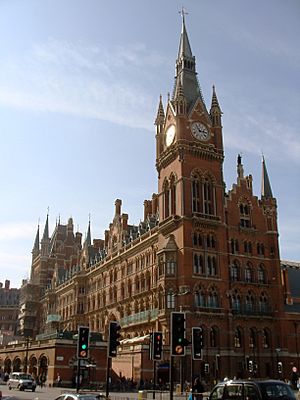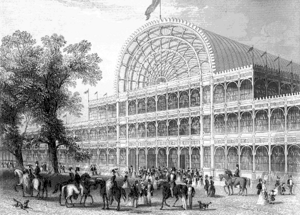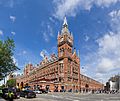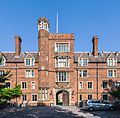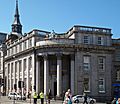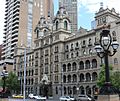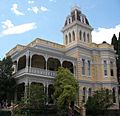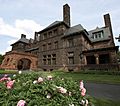Victorian architecture facts for kids
Victorian architecture describes many different building styles popular during the Victorian era. This period was when Queen Victoria ruled Britain, from 1837 to 1901. So, these buildings were designed and built during her time as queen.
Victorian architecture isn't just one style. It's a mix of several styles that were popular back then. Architects often looked back at older designs and gave them a new twist.
Contents
Popular Victorian Styles
During the Victorian era, several exciting architectural styles became popular. These styles often used new materials and ideas.
Gothic Revival Style
The Gothic Revival style was very popular. It looked back to the medieval Gothic cathedrals of the past. These buildings often have pointed arches, tall spires, and detailed stone carvings. They can look grand and impressive.
Famous examples include the St Pancras railway station in London, which opened in 1868. Another great example is the Houses of Parliament. This famous building was rebuilt between 1850 and 1870. The Natural History Museum also shows off the Gothic Revival style.
Buildings with New Technology
The Victorian era was a time of great invention. New materials and building methods changed architecture. One big example is the Crystal Palace, built in 1851. This amazing building was made mostly from cast iron and glass. It was a huge, light-filled structure.
This new way of building allowed for large, open spaces. You can see similar designs in old market halls, like those in Covent Garden. These buildings showed how new technology could create incredible spaces.
Arts and Crafts Movement
The Arts and Crafts movement offered a different approach. This style focused on creating buildings that felt more "human-scale." They used traditional building methods and natural materials. The idea was to make buildings that were well-crafted and fit into their surroundings.
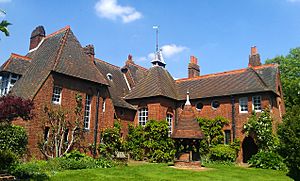
This movement influenced many new towns built in Britain in the late 1800s and early 1900s. The goal was to create beautiful, simple homes. A famous example is the Red House in Bexleyheath, designed by Philip Webb.
Images for kids
-
St. Pancras railway station and Midland Hotel in London, opened in 1868
-
Central Hall of the Natural History Museum, London
-
The Painted Ladies are an example of Victorian architecture found in San Francisco, California.
-
An example of residential architecture in the Old West End District (Toledo, Ohio), a well preserved historic district full of Victorian architecture
-
Palace of Westminster, Neo-Gothic completed in 1870. Designed by Sir Charles Barry and Augustus Pugin
-
Royal Albert Hall, London
-
The "Red Brick" Victoria Building at the University of Liverpool, completed in 1893 in Gothic Revival style. Designed by Alfred Waterhouse
-
The Victorian Pavilion at The Oval cricket ground in London
-
Victorian School of Art and Science at Stroud, Gloucestershire
-
House on the Hardwick House estate near Bury St Edmunds, Suffolk
-
The John Rylands Library in Manchester
-
The Aston Webb building at the University of Birmingham, UK
-
Victoria Law Courts, Birmingham, UK
-
The Gilbert Scott Building of the University of Glasgow, as viewed from Kelvingrove Park, Glasgow. An example of the Gothic Revival style
-
Balmoral Castle, completely rebuilt for Queen Victoria, an example of the Scots Baronial style
-
Walsall Victorian Arcade, UK
-
Barclays Bank building, Sutton, Greater London
-
Forth Rail Bridge, Firth of Forth, near Edinburgh, Scotland, UK
-
Melbourne's world heritage Royal Exhibition Building, built in 1880 (Free Classical)
-
General Post Office, Sydney in the Free Classical style (1891)
-
Hotel Windsor, 1885
-
St Peters Cathedral, Adelaide, South Australia (Gothic Revival)
-
Sydney Town Hall, in Second Empire style
-
Queen Victoria Building in Romanesque style (1898)
-
South Melbourne Town Hall in Second Empire style
-
St Mary's Cathedral, Sydney in Victorian Gothic architecture (1882)
-
State Library of Victoria of the Academic Classical style (1870)
-
North Terrace of the University of Adelaide in Victorian Tudor style
-
Italianate home in Randwick, New South Wales
-
Filigree style terraces in Surry Hills with ornate iron-wrought detailing
-
Pennsylvania Academy of Fine Arts, Philadelphia, by Frank Furness
-
Allegheny County Courthouse, Pittsburgh, Pennsylvania, by Henry Hobson Richardson
-
The California Southern Railroad's San Diego passenger terminal, built in 1887
-
Banff Springs Hotel, Banff National Park, Alberta, built in 1888
-
Brooklyn Bridge, 1883, New York City
-
John Steinbeck's childhood home in Salinas, California
-
Emlen Physick Estate in Cape May Historic District, New Jersey, by Frank Furness
-
The Saitta House, Dyker Heights, Brooklyn, New York, built in 1899 is designed in the Queen Anne style
-
1880s photo of 653 W Wrightwood (now 655 W Wrightwood) in the Lincoln Park neighborhood of Chicago, Illinois
-
The Italianate style Farnam Mansion in Oneida, New York. Built circa 1862
-
James J. Hill House in St. Paul, Minnesota, built in 1891
-
Series of Italianate tenements in Over-The-Rhine, Cincinnati, Ohio
-
Ford Piquette Avenue Plant, Detroit, Michigan, built 1904
-
Gingerbread trim on an 1882 house in Cape May, New Jersey
See also
 In Spanish: Arquitectura victoriana para niños
In Spanish: Arquitectura victoriana para niños


